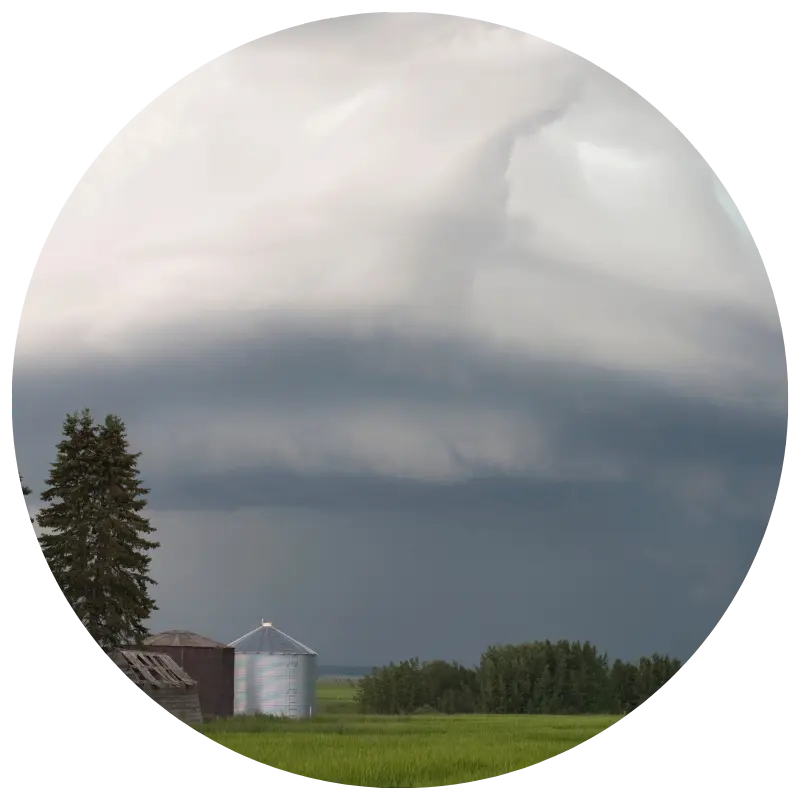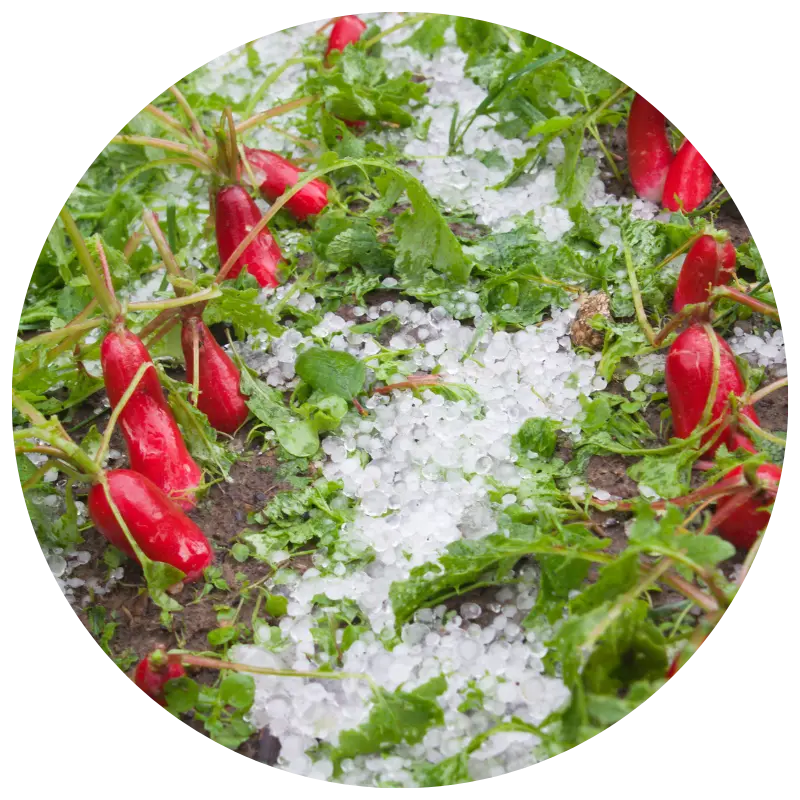Crop-Hail Insurance
Are you looking to protect your revenue? If you’re located in Tornado Alley or other hailstorm-prone areas, you should proactively secure hail coverage.


Hail can happen in any season and is often devastating to crops. In any given year, the USDA attributes approximately 6% of all crop losses to hail events. These events can be severe, widespread disasters or concentrated spot losses.
A crop-hail policy is supplemental insurance that addresses specific losses due to hail damage. Obtained directly from a private crop insurance company, crop-hail coverage can be purchased from a different vendor than your MPCI policy. Crop-hail policies are available in all 50 states and do not require you to insure your entire operation; you can select coverage on an acre-by-acre basis as needed.
You may not think of mortality as a problem with crops until the wall of clouds blows over and there is nothing but stubble left in your fields. Work with an MOMENTUM AG Agent to put a solid risk management plan with crop-hail insurance in place to potentially cover what your multi-peril crop insurance policy doesn’t.
What Does Crop-Hail Insurance Cover?
A standard crop hail policy covers a range of perils including hail damage, vandalism/malicious mischief, fire/lightning, and transit (covers the crop until the first place of storage). Policy endorsements can also be added to cover additional perils for certain crops.
Hail insurance can be an effective risk management tool and a great complement to MPCI, as well as acting as a standalone policy. Because coverage needs vary from grower to grower, many considerations must be made to determine which hail coverage may be a good fit in a farmer’s risk management plan, including:
- Type of hail plan / endorsements
- Crops grown
- Geographic location
- Deductible
- Amount of coverage per acre
- Risk tolerance
- Cost
Crop-Hail Insurance vs. MPCI
While MCPI provides general coverage for your operation, it isn’t specifically designed to protect against opportunity losses. A crop-hail policy, meanwhile, can help you manage risk of profit loss specifically caused by hail damage (in addition to other perils that might be covered under the policy).
Crop-hail insurance differs from MPCI coverage in three main ways:
- Crop-hail coverage is not a replacement for MPCI but rather supplemental coverage that addresses specific losses due to hail damage (and, in many cases, other perils such as fire, theft, vandalism, transit, storage structure, etc.).
- Crop-hail coverage is not offered through the Federal Crop Insurance Corporation, and your premiums aren’t federally subsidized. You also don’t have to insure your whole operation under a crop-hail policy, so you can choose coverage on an acre-by-acre basis as needed.
- You can easily customize crop-hail coverage levels to meet your operation’s specific needs, including opting for lower deductibles to cover spot losses.

What Types of Crop-Hail Coverage Plans are Available?
Dollar Plan
Dollar Plan coverage is set for a specified per acre amount at a specified deductible that can range from 0% deductible to 20% and above. A Dollar Plan is used to cover the entire crop from top to bottom. A loss is paid based on the deductible and the percent of adjusted damage.
Companion Plan
Companion Plan coverage is similar to Dollar Plan coverage in that there is some flexibility in choice of deductible and dollar amount of coverage. It is intended to cover the portion of the crop not covered by an MPCI policy. A loss is paid based on the deductible and the percent of adjusted damage.
Production Plan
Production Plan coverage works directly with a Multi-Peril Crop Insurance (MPCI) policy and uses unit-based production history to establish specific coverage guarantees. Under Production Plan coverage, harvested yield and percent of adjusted damage are used to determine loss payment.
Crop-Hail Insurance FAQ
-
How much hail coverage do I need?
-
The amount of hail coverage you need is dependent on your operation, so the answer varies from farmer to farmer. Everyone has a different perspective on coverage and appetite for risk. Different crops and crop values, as well as crop potential, can also weigh into the decision of how much coverage is needed.
Insurance companies have set dollar per acre liability limits based on each crop, but will make considerations to increase these limits on an individual basis if the value of the crop can be shown to exceed the liability limit.
Cost of coverage can be a major consideration in the amount of coverage being purchased. In some areas rates are exceptionally affordable due to the low probability of a hail event. In other areas the opposite is true.
-
What is the deadline to buy hail coverage?
-
There is no specific crop hail insurance deadline; most types of hail coverage can be purchased at any time during the crop’s growing season.
Some farmers purchase crop-hail coverage when the weather patterns are volatile, while others wait until the radar is purple and are hoping coverage will be bound before the hail hits. Be careful not to wait too long to apply, though. Many regions have a minimum two-hour waiting period (or longer in some areas) from the time you sign the hail application to when coverage is bound.
There are years when the market swings upwards and the value of the crop warrants increasing hail coverage to cover that value. When the market is in a downturn, often hail insurance coverage works with your multi-peril insurance to cover the cost of your inputs, keeping your operation whole when hail happens.
After a certain point, the insurance company may require a growing season inspection of the crop before the coverage will attach.
In many cases, crop specific endorsements that enhance the underlying hail policy do have purchase deadlines in order to access the additional peril. Generally, the insurance company will not immediately attach coverage, but it will attach at 12:01 AM the following day from when coverage was requested/applied for. In some cases, there is a binder provision that would apply in as little as two hours.
Not all growing seasons are available across all states. For example:
- December and January are not available in Colorado, Kansas, and Nebraska.
- December, January and February are not available in North Dakota and South Dakota.
Similar to the 12 available growing seasons, there are also 12 acreage reporting dates. Acreage Reporting dates are based on planting months; producer acreage reports are due the 5th of the month following the planting month. Acreage reports must be submitted by the due date to have coverage for the particular growing season.
For more information about growing season eligibility, acreage reporting dates and other coverage details, contact a Momentum Ag agent.
-
How should I consider market price fluctuations when making a crop-hail purchase?
-
Cost is an important factor when purchasing most items, and crop insurance is no exception. However, it is important to reexamine the value of your crop as markets change, as you lock in a production contract, as you reflect on the coverage in place with your MPCI policy, etc..
Bottom line, when crop values increase into the growing season where hail risk is present, you may want to consider adding crop-hail coverage or increasing coverage per acre if you have already taken it pre-planting.
Another area of particular concern would be when your yield potential seems to be outpacing your approved yield. Since this is the benchmark yield used for most crop insurance policies, you can be effectively underinsured in this scenario.
-
Can I buy additional hail coverage on top of what I’ve already purchased?
-
There are several available supplemental insurance coverage endorsements that complement the underlying hail coverage. The availability, cost, rules and provisions of these endorsements vary from one insurance company to another.
Examples of these endorsements include greensnap/wind for corn, open boll hail for cotton, soybean lodging, early season frost/freeze on sugar beets and fire/lightning coverage in small grains stubble.
If you have already purchased a hail policy, you can:
- Increase the amount of coverage on the current policy (the company may require inspection prior to attaching) as a way to stack multiple policy deductibles with the same company (as an example – $300/ac at 0% deductible and $200 at 5% deductible).
- Purchase an additional policy from another company.
What crops are most vulnerable to crop damage?
- Corn
- Soybeans
- Rice
- Cotton
- Small Grains (Wheat, Barley, Oats, Rye)
- And many others
Connect with an Agent
Call 866-878-7133 to speak with an agent or complete the form below for more information.
